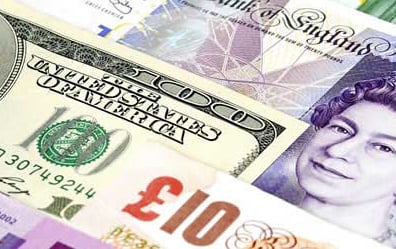EURUSD – Bears in complete control
Economic releases from the European Union last week continued to weaken an already bleak EU economic sentiment. Not only did the latest German IFO expectations and German Manufacturing PMI dash hopes Germany was returning to economic consistency, but the latest EU Markit PMI elevated fears of stagnant economic growth within Europe.
Comments from ECB President Mario Draghi that he remains committed to using all tools at his disposal to stimulate growth encouraged investors to price in future action from the ECB. All in all, the EURUSD declined by nearly 200 pips throughout the week and dropped to 1.26 for the first time in two years.
This Thursday, the latest ECB interest rate decision is announced and while I am not expecting the ECB to act again, Mario Draghi could use his press conference to send the EURUSD lower with dovish comments. Also this week, a variety of EU inflation data is released and optimists will be hoping a lower valued EURUSD may help raise CPI (Inflation) levels. However, the lower valued EURUSD failed to help the EU Markit PMIs last week and if the CPI data shows a similar correlation, we can expect the euro bears to awake again.
Advertisement
Overall, the EU sentiment has remained bleak for months and the Federal Reserve concluding QE in October is only going to reiterate to investors that the Fed are moving closer to normalizing monetary policy, and strengthen attraction to the Greenback. As long as the fundamentals for this pair remain consistent and this Friday’s US NFP fails to raise alarm bells, the EURUSD is on track to enter 1.25 by mid-October.
GBPUSD – Prime Minister Cameron wins support against the Islamic State
The pair commenced the week by moving to the upside and attempting to regain losses caused by the Scottish referendum the week prior.
Advertisement
However, the pair found stubborn resistance around the 1.6408 area and the announcement that UK Prime Minister, David Cameron, would call in parliament to vote on joining the international coalition against the Islamic State (which parliament voted anonymously in favour for) sent the pair to the low 1.62s.
News of the UK joining the international coalition has flustered investors who were only just beginning to regain confidence in the GBPUSD pair following the Scottish referendum. However, I feel it will require military troops to be deployed into the Middle East before any substantial decline in the GBP is noticed.
In the meantime, investors are still waiting for Westminster to formally define what extra political powers Scotland will be granted now that it has voted to stay within the United Kingdom. When this is confirmed, the prospects for the pair will be bullish. This Tuesday morning, it is widely expected that the UK’s second quarter GDP will be confirmed as having expanded by 3.2%. This will heighten demand for an interest rate rise, which Bank of England (BoE) Governor Carney stated only on Thursday last week was “getting closer”. The BoE are set to raise rates in Spring 2015 and this is something that hasn’t been priced into the pair yet. Once Westminster finally defines Scotland’s extra political powers, this pair looks set to rally.
Aussie downside moves accelerate
Advertisement
The Aussie continued to move to the downside last week, validating the Reserve Bank of Australia’s (RBA) previous comments that investors were underestimating the risk of a decline in the Australian currency.
Economic data from Australia was low in volume, but the Australian Security Intelligence Organisation (ASIO) raising Australia’s terror level to “high” following a major police operation the week prior has clearly agitated investors.
The upcoming week is going to be a busy one for Australia, with a large variety of economic releases scheduled. This includes the latest consumer confidence, retail sales, commodity report, trade balance, building approvals and RBA annual report.
Although the RBA had previously stated that the currency remained “overvalued” for months and Governor Stevens was explicit in suggesting that “investors were underestimating the chances of a significant drop in the AUD” the recent downturn has been accelerated by security concerns, not necessarily disappointing economic performances. The RBA had also previously warned that Australia was set to enter a weaker period of economic growth and if this week’s data provides validity to those claims, the bear run for this pair might not be over yet.
Advertisement
The technicals on the Daily timeframe clearly shows how weakly the Aussie has performed since falling from its pennant/triangle pattern. The pair now firmly finds itself in a bearish channel and it would likely require a very weak US NFP on Friday to inspire rise appetite and test this technical pattern. In the meantime, Aussie support can be found around 0.8683, 0.8676 and the current yearly low, 0.8659. If the Aussie attempts to recover losses, resistance can be found at 0.8770.
Gold suggests a consolidation period
Advertisement
United States President, Barack Obama announcing that the United States and Arab allies had participated in air strikes in Syria led to a short term spike in Gold. Still, the commodity failed to rise higher than $20 and traded narrowly for the remainder of the week.
Despite the United Kingdom voting to join the international coalition against the Islamic State and the completely unexpected emergency of political unrest in Hong Kong, Gold barely moved in valuation. This is unusual considering investors usually seek safe-havens in times of political uncertainty and goes further towards showing the lack of buyers in the Gold market at present.
Advertisement
The upcoming week is heavy with United States economic releases, including the latest US Consumer Confidence, ADP Employment Change, ISM Manufacturing and US Non-Farm Payroll. As long as economic indicators continue to suggest that the United States economy is improving, a gradual decline in Gold should resume.
Investors are fully aware that the US economy is improving, with the Federal Reserve are set to conclude QE in just a few weeks. This is seen by many as a major step towards moving closer to normalizing monetary policy and as long as US economic data remains consistent, Gold looks set to continue gradually declining towards the December 2013 low, 1182.46 in the coming weeks.
Advertisement
*Ahmad is chief market analyst at FXTM.
Add a comment







